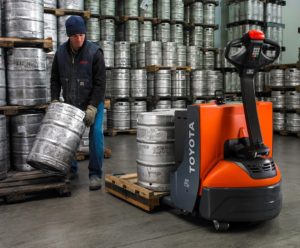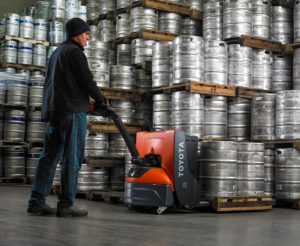Archive for November, 2018
Cold Room Forklift and the Battle Against Condensation
 Operating forklifts in cold storage facilities can often present several challenges that can limit the success of a company’s operations. To make sure you have the best facility design and forklifts for the job, consider reaching out to one of our warehouse consultants to enhance safety and increase efficiencies.
Operating forklifts in cold storage facilities can often present several challenges that can limit the success of a company’s operations. To make sure you have the best facility design and forklifts for the job, consider reaching out to one of our warehouse consultants to enhance safety and increase efficiencies.
One of the most important tasks a forklift user faces during cold room operations is the need to reduce condensation while in warm temperatures, which helps prevent freezing when re-entering a frigid space. Freezing is known to cause inefficient operation and downtime of forklifts, which can lead to lost throughput for the cold operations. A few simple practices can help to prevent these inefficiencies, providing maximum use of the forklift fleet while maintaining your return on investment.
Storing Your Cold Room Forklift
A major key to maintaining efficiencies is the storage of your forklift! Storing your forklift in freezing temperatures for too long can lead breaking parts and even battery failures. The best practice for storing a cold room forklift when not in use is to do so outside of the cold area. However, this may create a condensation issue. The best solution for this is to store your forklift in a dry area that’s just above freezing temperatures in order to ensure that condensation forms slowly, or not at all.
In cases where this isn’t always possible, you need to provide enough time for the forklift to rest outside of the cold facility in warm temperatures, so that the condensation can then evaporate. This process can be accelerated by the use of fans in the storage space. Keep in mind that operating too soon before evaporation can lead to freezing.
Using a Cold Room Forklift in Changing Temperature Applications
 In many operations, cold storage environments are often intermixed with warmer spaces. For example, movement from a cold storage room to a cold truck may require passing through a warm docking area. This presents some situations where condensation may be inevitable, but there are certain steps that can help.
In many operations, cold storage environments are often intermixed with warmer spaces. For example, movement from a cold storage room to a cold truck may require passing through a warm docking area. This presents some situations where condensation may be inevitable, but there are certain steps that can help.
If it is within your budget to keep multiple forklifts on hand with specialized areas of operation, that can help prevent the potential wear and tear from changing temperatures. This will increase the necessary touches between equipment to move the product, but depending on your circumstances, may also increase the operational value and efficiency of your forklifts. Try performing a site analysis to determine if this is a useful approach.
If maintaining multiple forklifts is out of the question, you can still take steps to prevent condensation challenges. For example, the design of your facility is key! Optimizing the routes that your forklifts must take in order to move products can help ensure that they stay in cold spaces as much as possible. Additionally, limiting the number of times a cold room forklift needs to change environments is key to reducing the chances of condensation.
Choosing the Right Cold Room Forklift
Selecting the right forklift for your cold room application can have a major impact on efficiencies and your return on investment. Forklifts with fewer moving parts and wires reduce components’ heat production and the chance of condensation affecting your forklifts. Toyota Electric Forklifts are engineered with as few moving parts, AC motors, and controllers as possible to reduce internal component heat generation. These small engineering feats can have an incredible impact on operation efficiency.
While condensation isn’t the only challenge facing cold room forklift operators, it is still one of the most pressing concerns when it comes to the mechanical efficiency of your forklifts in cold environments.
